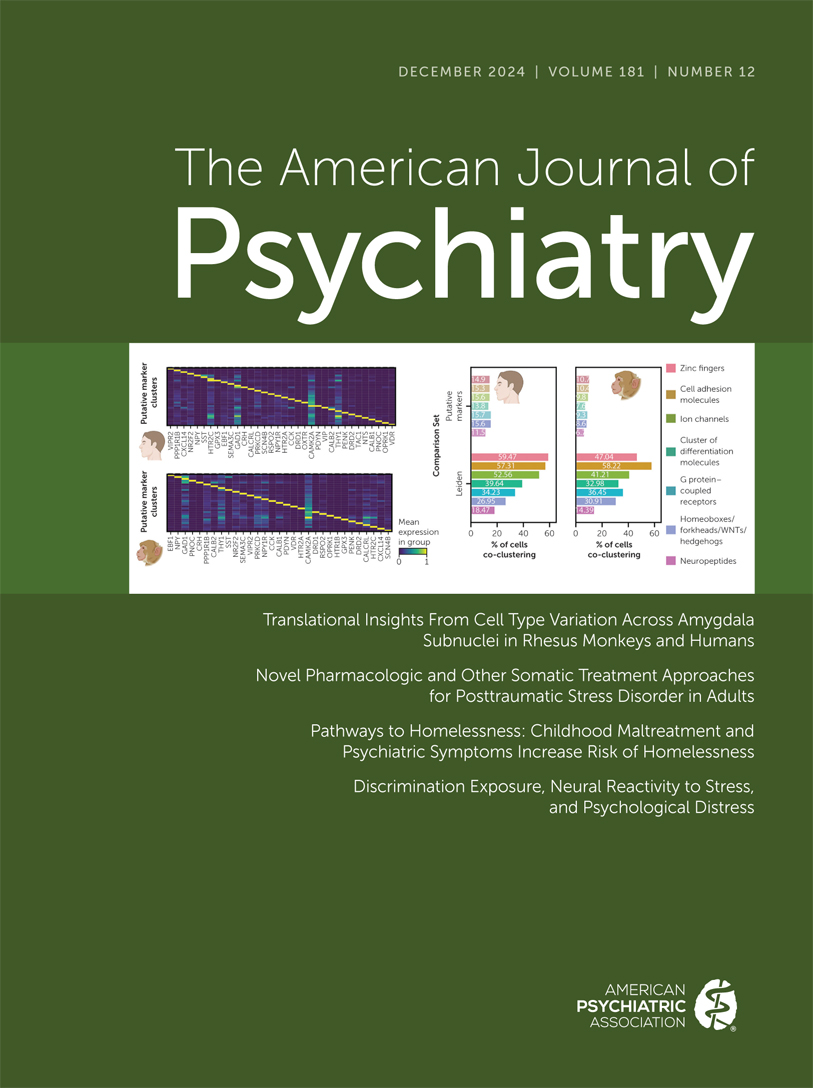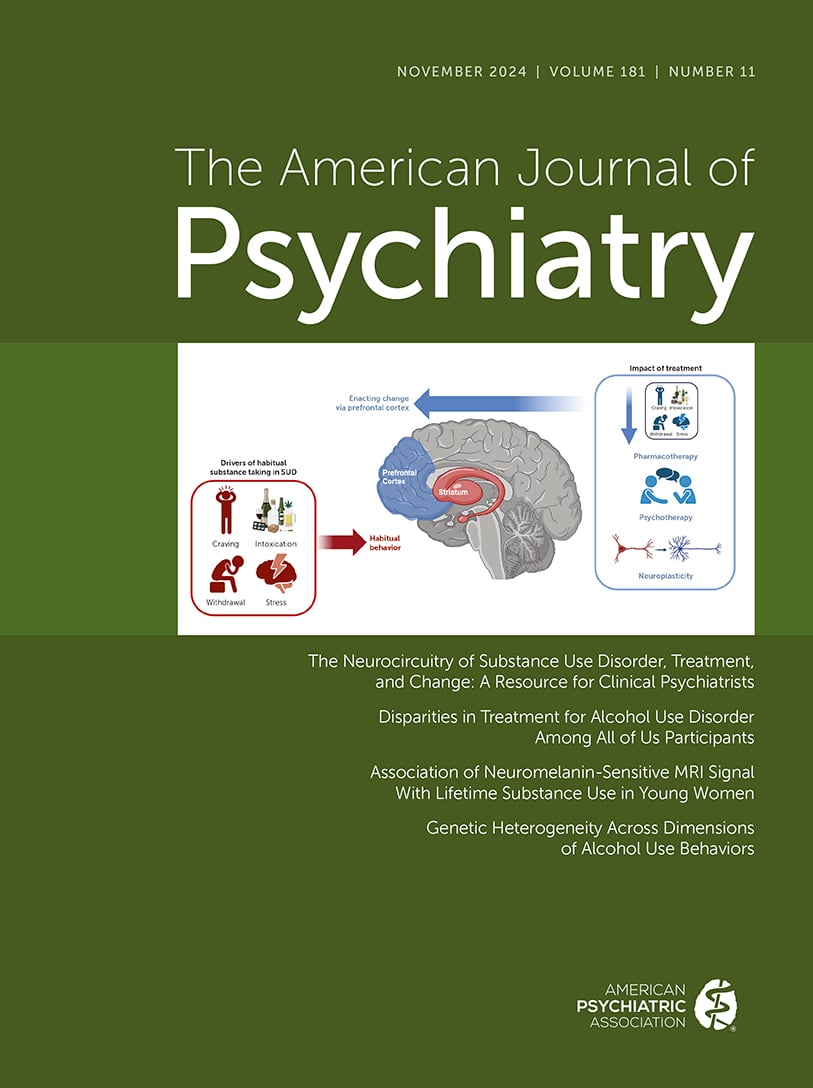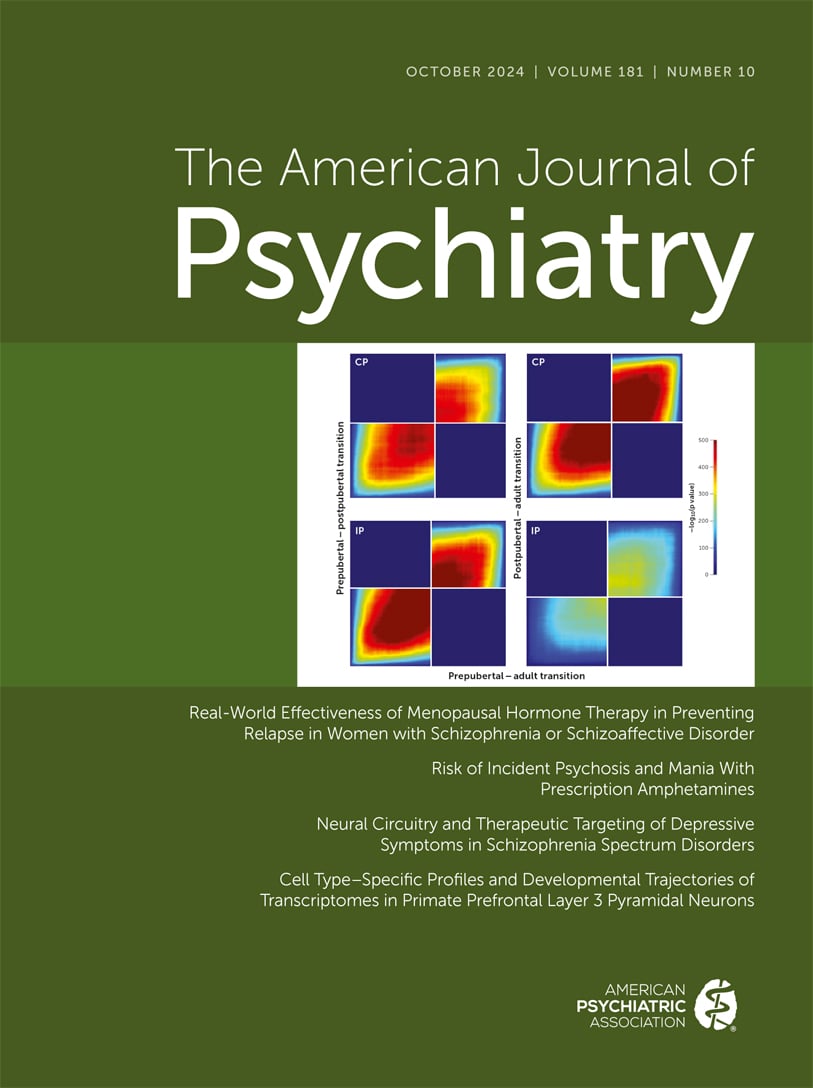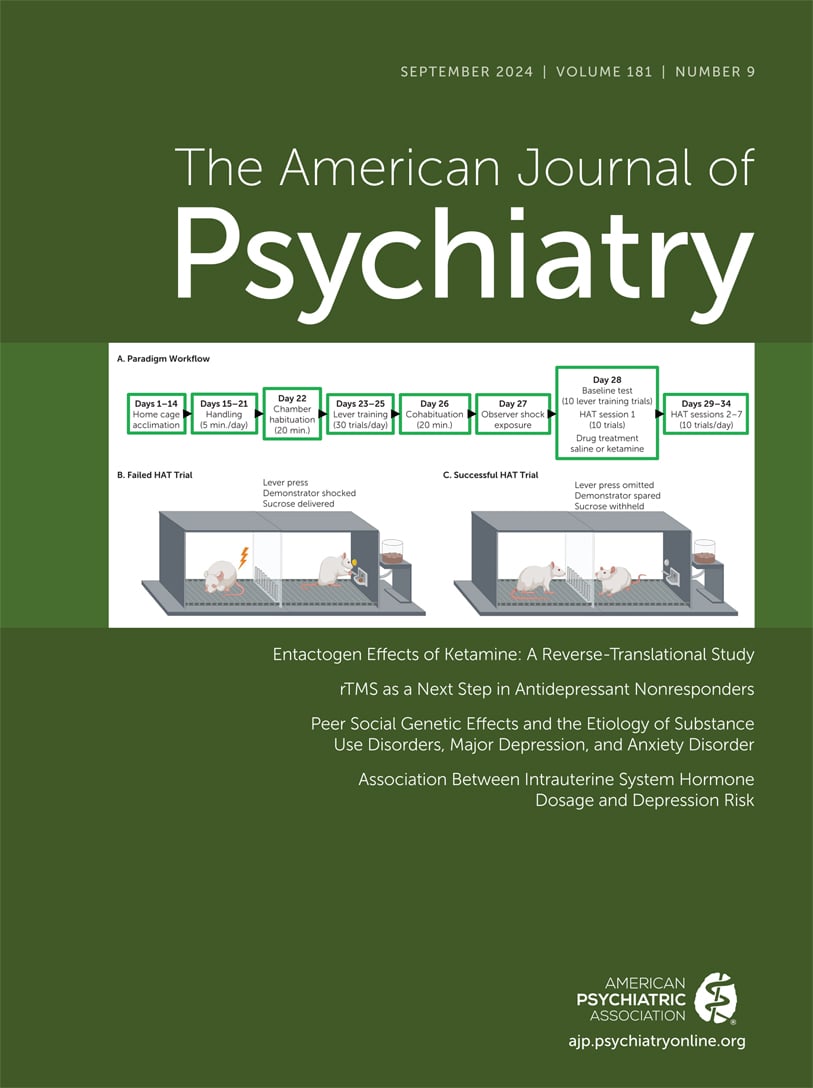American Journal of Psychiatry
- Volume 161
- Number 4
- April 2004
In This Issue
Editorial
Reviews and Overviews
Publication date: 01 April 2004
Pages598–607OBJECTIVE: A number of studies have used magnetic resonance imaging to examine volumetric differences in temporal structures in subjects suffering from major depressive disorder. Studies have reported lower hippocampal and amygdala volume, but results ...
https://doi.org/10.1176/appi.ajp.161.4.598Publication date: 01 April 2004
Pages608–620OBJECTIVE: Bipolar disorder affects 0.5%–1.5% of individuals in the United States. The typical age at onset is late adolescence or early adulthood, placing women at risk for episodes throughout their reproductive years. General guidelines for the ...
https://doi.org/10.1176/appi.ajp.161.4.608Images in Neuroscience
Introspections
Images in Psychiatry
Article
Publication date: 01 April 2004
Pages625–630OBJECTIVE: The age at onset of bipolar disorder is associated with clinical features of the illness, including duration, severity, and pattern of comorbidity with other disorders. Age at onset is familial and heritable, and it correlates inversely with ...
https://doi.org/10.1176/appi.ajp.161.4.625Publication date: 01 April 2004
Pages631–636OBJECTIVE: Three potent risk factors for major depression are female sex, the personality trait of neuroticism, and adversity resulting from exposure to stressful life events. Little is known about how they interrelate in the etiology of depressive ...
https://doi.org/10.1176/appi.ajp.161.4.631Publication date: 01 April 2004
Pages637–645OBJECTIVE: Prior studies showed that subjects with major depression have deficits in hippocampal-based verbal declarative memory (e.g., recall of a paragraph) and in hippocampal and prefrontal cortical functioning and structure. The purpose of the present ...
https://doi.org/10.1176/appi.ajp.161.4.637Publication date: 01 April 2004
Pages646–653OBJECTIVE: The validity of the distinctions between dysthymic disorder, chronic major depressive disorder, and episodic major depressive disorder was examined in a family study of a large community sample of young adults. METHOD: First-degree relatives (N=...
https://doi.org/10.1176/appi.ajp.161.4.646Publication date: 01 April 2004
Pages654–661OBJECTIVE: Most depression treatment guidelines emphasize treatment with antidepressant medication and recommend that benzodiazepine use be minimized, particularly among elderly patients. However, little is known about patterns of benzodiazepine use in ...
https://doi.org/10.1176/appi.ajp.161.4.654Publication date: 01 April 2004
Pages662–669OBJECTIVE: Autism/autistic disorder (MIM number 209850) is a complex, largely genetic psychiatric disorder. The authors recently mapped a susceptibility locus for autism to chromosome region 2q24-q33 (MIM number 606053). In the present study, genes across ...
https://doi.org/10.1176/appi.ajp.161.4.662Publication date: 01 April 2004
Pages670–676OBJECTIVE: The relationship of parental alcohol or drug diagnosis to offspring personality was examined in a population-based sample of 17-year-old twins (568 girls and 479 boys) participating in the Minnesota Twin Family Study. Whether offspring ...
https://doi.org/10.1176/appi.ajp.161.4.670Publication date: 01 April 2004
Pages677–684OBJECTIVE: This study determined the long-term safety and effectiveness of risperidone in treating severe disruptive behavior in children with subaverage intelligence. METHOD: This 48-week, open-label extension included 107 children ages 5–12 years with ...
https://doi.org/10.1176/appi.ajp.161.4.677Publication date: 01 April 2004
Pages685–691OBJECTIVE: Children of fathers with substance use disorders are at increased risk for psychopathology, including conduct disorder, attention deficit hyperactivity disorder (ADHD), major depressive disorder, and anxiety disorders. This study examined the ...
https://doi.org/10.1176/appi.ajp.161.4.685Publication date: 01 April 2004
Pages692–699OBJECTIVE: The authors’ goal was to evaluate the relationship between adherence to treatment with antipsychotic medication and health expenditures. A secondary objective was to identify risk factors predictive of nonadherence. METHOD: Data included ...
https://doi.org/10.1176/appi.ajp.161.4.692Publication date: 01 April 2004
Pages700–706OBJECTIVE: Since use of multiple drugs to treat psychiatric patients is increasing, and research on this practice is rare, the authors carried out a retrospective case-control study of multiple versus single antipsychotic treatment in psychiatric ...
https://doi.org/10.1176/appi.ajp.161.4.700Publication date: 01 April 2004
Pages707–715Background: Previous studies have reported evidence of structural and functional abnormalities in the anterior cingulate cortex of patients with schizophrenia. METHOD: The authors studied 19 male patients with chronic schizophrenia and 15 healthy male ...
https://doi.org/10.1176/appi.ajp.161.4.707Publication date: 01 April 2004
Pages716–727OBJECTIVE: This study examined the pattern of criminal convictions in persons with schizophrenia over a 25-year period marked by both radical deinstitutionalization and increasing rates of substance abuse problems among persons with schizophrenia in the ...
https://doi.org/10.1176/appi.ajp.161.4.716Publication date: 01 April 2004
Pages728–735OBJECTIVE: A modified autonomous response (e.g., electrodermal activity) in subjects with alexithymia (a reduced ability to identify and communicate emotions) while processing emotional information is well known. However, the functional and ...
https://doi.org/10.1176/appi.ajp.161.4.728Brief Report
Publication date: 01 April 2004
Pages736–738OBJECTIVE: This study characterized cognitive functioning in elderly patients with bipolar disorder. METHOD: The cognitive functioning of 18 euthymic patients with a history of bipolar disorder I or II, ages 60 years and older, was tested with the Mini-...
https://doi.org/10.1176/appi.ajp.161.4.736Publication date: 01 April 2004
Pages739–742OBJECTIVE: Inhibition mediated by γ-aminobutyric acid at the axon initial segment of pyramidal neurons appears to be altered in the prefrontal cortex in schizophrenia. This study examined the densities and laminar distribution of axon initial segments ...
https://doi.org/10.1176/appi.ajp.161.4.739Publication date: 01 April 2004
Pages742–744OBJECTIVE: Morphological indications of abnormal circuitry have been detected in the prefrontal neuropil of patients with schizophrenia. The authors tested the hypothesis that schizophrenia is associated with smaller dendritic field size in layer V ...
https://doi.org/10.1176/appi.ajp.161.4.742Publication date: 01 April 2004
Pages745–747OBJECTIVE: Although it is well established that cerebral activation increases with higher task load, the potential effects of training have been investigated over brief periods only. Training is of potential clinical relevance since training programs are ...
https://doi.org/10.1176/appi.ajp.161.4.745Publication date: 01 April 2004
Pages748–751OBJECTIVE: The authors’ goal was to identify differences in regional brain activity between physiological and benzodiazepine-induced sleep to clarify the brain structures involved in the drug’s hypnotic effect. METHOD: Using positron emission tomography, ...
https://doi.org/10.1176/appi.ajp.161.4.748Publication date: 01 April 2004
Pages751–755OBJECTIVE: Alcoholism carries a liability of balance and gait instability that persists with sobriety. Such deficits are less well documented in schizophrenia and may be compounded by comorbidity with alcoholism, which is prevalent in schizophrenia. ...
https://doi.org/10.1176/appi.ajp.161.4.751Letter to the Editor
Book Forum: Psychosomatic Medicine
Book Forum: Other Subspecialties
Book Forum: Mind and Brain
Book Forum: Textbooks
Book Forum: Consulting Psychology
Correction
Past Issues
View Issues Archive
Vol. 181 | No. 12

Vol. 181 | No. 11

Vol. 181 | No. 10
